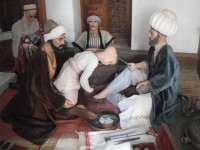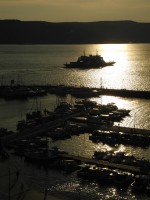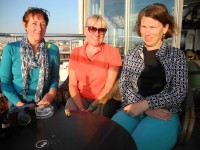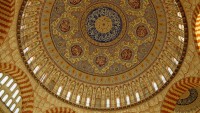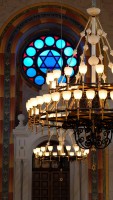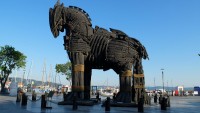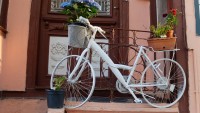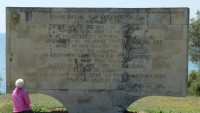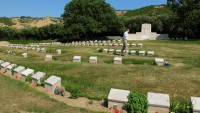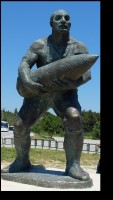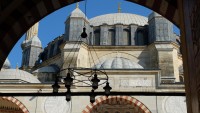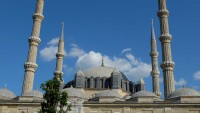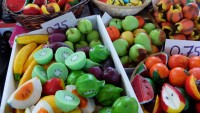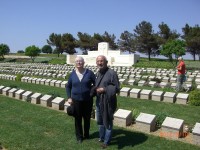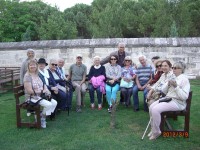When we met at Bodrum airport on the morning of 12th of May to board the Istanbul plane, our group was 14 people. The remaining five joined us at Istanbul and Edirne bringing the total to 19.
At Istanbul Atatürk Airport we were met by our guide Aida hanım (it seems her mother was an opera fan) and our friends joining us in Istanbul. We reached Edirne after a three and half hour comfortable bus journey. We were hungry so we rushed to sample the famous Edirne style fried lamb’s liver. It is very tasty when eaten while it is hot.
After a quick look at the old town centre, we got back on the bus and crossed the Maritsa River to look at the historical Darüşşifa (medical school), which is now being turned into a health museum. Unfortunately we could only see the medical school section because the more interesting hospital section was being renovated and not open to the public until the following day.
Edirne is located at an important road junction linking Istanbul to Europe as well as being at the confluence of three rivers. According to the military historian John Keegan, Edirne has experienced more war and occupation than any other city in the world – 16 wars and occupations. But it flourished during the time of the Roman emperor Hadrian, hence the name Hadrianapolis.
Edirne was the capital of the Ottomans for 92 years before the conquest of Constantinople in 1453. The old city is full of history. At every turn there were mosques, covered bazaars, civil complexes including libraries, schools, hospitals and soup kitchens, old churches and synagogues. Also the founder of Baha’i religion, Bahaullah, spent many years in Edirne after being exiled from Iran in the 19th century and started teaching his faith there. The houses he lived in while he was in Edirne were restored by the Baha’i community and are visited by his followers.
We visited the Great Edirne Synagogue, the third largest synagogue in Europe. It has just been restored after lying derelict for many years. It doesn’t have a congregation so services will be held there only on special occasions. The restoration was very successful and the whole building now is breath-taking. İzzet Keribar’s photography exhibition was also a treat for the eyes, especially for those members of the H3A photography group that were with us.
Of course there are also many mosques in the city, and the most important is Selimiye. It was built during the reign of Sultan Selim II between 1568 and 1574. The architect was the grand master of the Ottoman architects, Mimar Sinan. This mosque has a special significance for me. My maternal great grandparents were among the many millions of Turks and Muslims who were massacred and expelled from the Balkans, Crimea and the Caucasus by the Slavs, especially the Russians, during the 19th and early 20th centuries. My grandparents were born in their refugee tents erected in the grounds of the Selimiye Mosque and called Selim and Selime respectively.
Selimiye Mosque is the product of Sinan’s mature period. He was in his late eighties during the construction. While conventional mosques were limited by a segmented interior, Sinan’s effort at Edirne was a structure that made it possible to see the mihrab from any location within the mosque. Surrounded by four tall minarets, the mosque has the largest dome on top of it. Around the rest of the mosque are many additions: libraries, schools, hospices, baths, markets, hospitals a cemetery and soup kitchens for the poor. It is a UNESCO World Heritage site and one of the pinnacles of Muslim architecture together with the Taj Mahal and the Alhambra Palace.
There are many other places worth seeing in Edirne, but this was all we had time for. We finally reached our hotel the, Kervansaray, located in the city centre. It is a medium sized new hotel which blends in well with the local architecture. Almost everyone was satisfied.
* * *
As we depart for the Gallipoli peninsula the following morning, I can sense a feeling of excitement from everyone; they must all have had their own reasons. After a two hour journey to the south we have a break at a petrol station near Gelibolu where we get a good view of the Dardanelles, one of the busiest and most important waterways in the world. It looks blue and very beautiful.
From Eceabat we continue southwards. After passing Kilitbahir Castle and the fortifications we have a photo break at Seyit Onbaşı monument, commemorating the corporal who lifted 230 kilo gun shells single handed. We are now opposite Çanakkale. The crossing is very busy with small boats and ferries used by the people commuting to and from Çanakkale.
Our next stop is the Turkish monument located at Hisarlık Tepe near Morto Bay. Its gigantic columns stand 41.7 metres high from the ground, commanding the southern entrance to the Dardanelles. The names of tens of thousands of Turkish martyrs are commemorated there. Thousands of people have come to pay their respects that day. The car parks are full of buses from all parts of Turkey.
We continue towards the southern tip of the peninsula. After seeing the French monument from a distance we arrive at the Cape Helles monument rising 33 metres above the ground. It was erected in 1924 by the British authorities. The inscriptions on the monument contain the names of more than 21,000 dead from the allies side (mainly British) as well as all the ships and military units that took part in the operations. The memorial is excellently maintained by the Commonwealth War Graves Commission. In fact we found that the whole peninsula (which is a national park) was well looked after by the authorities.
Our next stop was the Lancashire landing cemetery about a kilometre to the west of Cape Helles. It is like a park, full of flowers, very well looked after. It contains mainly the graves of 1200 members of the Lancashire Fusiliers Regiment. A lot of them were boys of 20 or even younger. Naturally my wife, Camille, was very emotional as her grandfather and her father served in this regiment in the two world wars. She kept saying “What were these poor boys doing here? Who sent them to their deaths in these faraway lands?”
Then we headed north. Our first destination was the Anzac Cove. After Kabatepe the topography of the land changed, becoming very rough and craggy. Not exactly the ideal landing place. Some people say ANZACS were given the wrong maps; others say it was a decoy. A few weeks previously, on 25th of April 2015, ANZACS commemorated the 100th anniversary of their landing here, with a memorial service which started at 4.30 in the morning.
Kemal Atatürk’s words to the ANZAC mothers, written on the monument at the Anzac Cove memorial area, may have provided some consolation to them: “You, the mothers, who sent their sons from far away countries, wipe away your tears. Your sons are now lying in our bosom and are in peace. After having lost their lives on this land they have become our sons as well.” Their deaths in these faraway lands sparked Australians’ and New Zealanders’ first national awakening.
In our group were Nimla Heplevent and her elder sister and our old family friend Gül Önür. Their grandfather, first lieutenant Nazif Çakmaklı, lost his life 100 years ago at Chunuk Bair (Conk Bayırı) during a bayonet charge. They wanted to find and visit his grave for the first time in their lives. Yes, it was there! In fact there is even a small monument to his name. The Turkish members of the group were grateful to all those who have fallen for our country, when our backs were to the wall and our country was in danger of being wiped off the face of the Earth.
You really need several days to explore the Gallipoli Peninsula properly. But we called it a day and took the ferry from Eceabat to Çanakkale. After a short crossing, we arrived in Çanakkale and checked into Akol Hotel which is very close to the ferry station and located on the seafront.
Çanakkale has become an important university city; the streets and cafes are full of young people who are drinking their beers and enjoying themselves. There is no sign of provincialism and conservatism which you find in most Anatolian cities. There are small fishing boats just outside the harbour and local fishermen are selling their catch by the sea front. Most of our group have enjoyed their evening exploring the streets of Çanakkale.
On our third morning we visited Troy, 40 minutes by bus from Çanakkale. Troy is another UNESCO World Heritage site. This will be our second visit with H3A and I have been many times. Though not as spectacular as Ephesus or Pergamon it is very important archeologically. In fact the very first archaeological excavation in history, was conducted here by Heinrich Schliemann in 1871.
My eyes are searching for some clue to the late Professor Manfred Korfmann who I personally met many times. He completely changed the world’s biased views on Troy. He stated that Trojan’s were not Greek but an Anatolian people but he was scorned and expelled by the German academia. He died in bitter disappointment at the age of 63 from cancer. I hope the new Troy museum to be opened to the public soon, will honour his services. I was lucky to come across Professor Rüstem Arslan who was his assistant. He promised to come to Bodrum to give us a lecture on the subject.
Our group had to be back in Istanbul that evening to catch their plane to Bodrum. So at midday we returned to Çanakkale. Camille and I caught the local bus to our village house at Adatepe and the rest of the group continued their journey to Istanbul.
Text Selçuk Şahin
Photos Richard Woodman, Bilgin Engineri, Kim Gould

